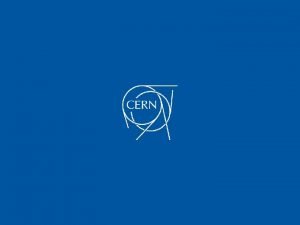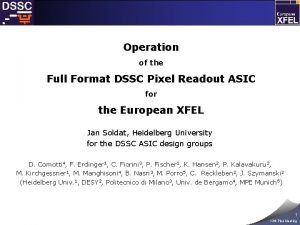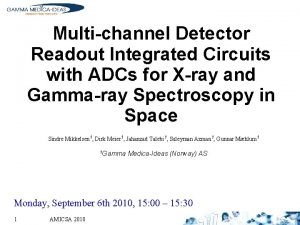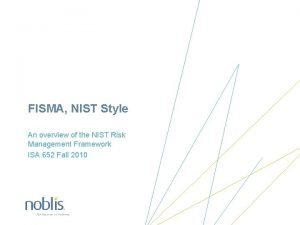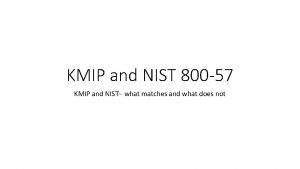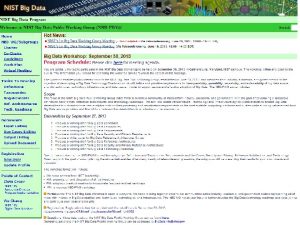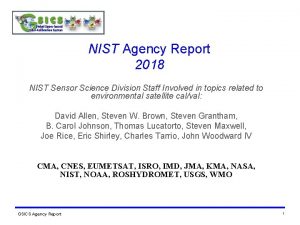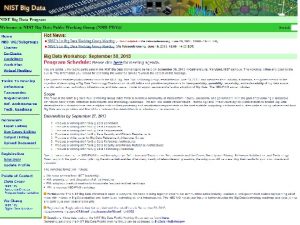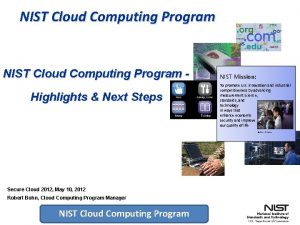Some thoughts on readout Joel Ullom NIST joel












- Slides: 12

Some thoughts on readout Joel Ullom NIST joel. ullom@nist. gov 1

Time Division SQUID multiplexing (TDM): concept each colored block is 1 sensor • DC biased TES • each TES coupled to one SQ 1 • rows of SQ 1 s turned on and off sequentially • each SQ 1 in flux-locked loop • wire count scales as N+M, whereas detector count scales as N*M • TRL = 6 (33 channels per column) in SPIDER balloon flight 2015 Joel Ullom 2

TDM: performance • Used in mm/sub-mm instruments: ACT, ACTPol, Advanced ACTPol, ABS, BICEP 2, BICEP 3, CLASS, HAWK+, PIPER, GISMO 1, GISMO 2, Keck Array, MUSTANG, SCUBA 2, SPIDER, ZEUS 2 • highest mux-factor in deployed instrument: 40 in SCUBA 2 • highest mux factor under development: 64 (advanced ACTPol, Henderson et al 2016) • highest pixel-count array demonstrated on the sky: 10, 000 SCUBA 2 • readout area per channel at m. K stage = 3. 6 mm 2 • wire-count for 6000 sensors 33 x 1 SQUID multiplexer 2 D multiplexer – – – ~1, 300 channels • cross-talk – 75 mm HAWC+, PIPER, SCUBA 2 300 K to 4 K: 530 twisted pair 4 K to m. K: 439 twisted pair (assumes x 64 and 1 detector bias pair per column) 0. 25% nearest neighbor, <0. 03% for rest (de. Korte 2003, B 2 instrument paper) • when bias circuit optimized, negligible noise degradation due to readout • dissipates ~1. 8 n. W/column at coldest stage Joel Ullom 3

TDM: readout • Multi Channel Electronics (MCE) developed at University of British Columbia • 37 m. W/channel – 2048 channels/crate (assuming 64 rows per column) – 75 W/crate • SCUBA 2, ACTPol, ABS, SPIDER, NIST THz imager • TRL=6 (SPIDER 2015) • Also, SPACECUBE implementation under development at GSFC; TDM electronics in space-qualified framework; about 100 m. W/channel Joel Ullom 4

MHz Frequency Division SQUID multiplexing: concept • • AC biased TES LC for each sensor (~300 k. Hz – few MHz) N sensors coupled to one SQUID series array (N_mux) wire count from 4 K to m. K stage: 2 x N_tes/N_mux Two separate development efforts/architectures: UC Berkeley/Mc. Gill and SRON TRL = 6 (N_mux = 16, EBEX flight 2013) Baseline readout for Lite. BIRD Joel Ullom 5

MHz FDM: performance • • • Used in mm/sub-mm instruments APEXSZ, EBEX, Polar. Bear/Simon’s Array, SPTpol, SPT-3 G highest mux factor achieved in deployed instrument: 16 (EBEX, Mc. Dermid 2014) highest mux factor under development: 64 (SPT-3 G) – • • Hattori LTD 16 • highest pixel-count array demonstrated on the sky: 1, 536 (SPTpol, Austermann 2012) Readout area per channel at m. K stage = 60 mm 2 (silicon LC chips only) wire count for 6000 sensors – – – • • lab demonstration (Bender et al 2014) 300 K to 4 K: 375 twisted pairs 4 K to m. K: 94 low inductance pairs assumes x 64 multiplexing Xtalk: <1% is the goal (Hattori 2016) When bias circuit optimized, negligible noise degradation due to readout Demonstrated systems used surface mount capacitors and lithographed inductors. Fully lithographed circuits possible. Depending on SQUID array location, no dissipation at focal plane SQUID Series Array Joel Ullom 6

MHz FDM: readout • Developed at Mc. Gill University and SRON • Power consumption – 330 m. W/channel (x 16 MUX, EBEX 2013, Mc. Dermid 2014) – 49 m. W/channel with new FPGA chips and x 64 MUX (Bender et al. 2014) • EBEX, SPTpol, Polar. Bear • Space optimized hardware shown on the left. Key components brought to TRL 5. Joel Ullom 7

Microwave SQUID multiplexer: concept Sensor circuit Mates ASC 2014 Joel Ullom 8

Microwave SQUID multiplexing • • Frequency scalability of MKIDs + proven sensitivity of TES 32 channels demonstrated in season 1 of MUSTANG 2 64 channel demonstration on MUSTANG 2 this season scales to ~1000 channels Joel Ullom 9

Electronics for GHz readout • MKID and microwave SQUID extremely similar but not identical • Useful bandwidth typically set by ADCs and DACs with high effective number of bits: 500 MHz – 1 GHz typical. Can obtain more bandwidth per HEMT with additional ADCs and DACs • Several implementations: – ROACH, ROACH 2. Used in MUSTANG, ARCONS (ground) & BLAST-TNG (balloon) – SPACEKIDs – Others? SLAC, 4 DSP, … • 100 & 500 m. W/channel for Bonn/SRON & Grenoble electronics [Weds] Joel Ullom 10

TDM vs MHz FDM for TESs • We are pursuing both at NIST; this provides a clear-eyed perspective on strengths and weaknesses • Both are candidates • Both have been used in challenging environments including balloons (SPIDER, EBEX) • Multiplexing factors are similar – TDM 64: 1 for Advanced ACTPol – FDM 64: 1 for SPT 3 G • Power/channel in readout electronics similar • Progress has been made on space-qualified electronics for both (SPACECUBE, Mc. Gill & SAFARI). • DC-biased TES operation can be easier than AC-biased • TDM is >10 x more compact: L/R filters vs LC • FDM usually requires fewer wires to the focal plane • FDM usually requires less power dissipation at the focal plane but the dissipation from TDM is seldom significant joel. ullom@nist. gov 11

MHz vs GHz Readout • We are pursuing both MHz and GHz readout at NIST; this provides a clear-eyed perspective on strengths and weaknesses • Both are candidates • TRL of GHz readout is lower but there is time for it to mature • GHz readout will provide higher multiplexing factors, but CORE isn’t an extreme consumer of readout bandwidth – Intermediate sensor count – Low bandwidth per sensor • In implementations so far, GHz control electronics dissipate more power per channel: 100 m. W/channel (GHz) vs 37 - 49 m. W/channel (TDM, FDM). This is not a universal law: a more detailed analysis of the power limits is needed. joel. ullom@nist. gov 12
 Readout units
Readout units Readout device
Readout device Full pixel readout
Full pixel readout Readout integrated circuit
Readout integrated circuit My thoughts are not your thoughts
My thoughts are not your thoughts Some thoughts to ponder
Some thoughts to ponder Fire and ice diamante poem
Fire and ice diamante poem Sometimes you win some sometimes you lose some
Sometimes you win some sometimes you lose some Some say the world will end in fire some say in ice
Some say the world will end in fire some say in ice Ice cream count or noncount
Ice cream count or noncount Some may trust in horses
Some may trust in horses Contact vs noncontact forces
Contact vs noncontact forces Sometimes you win some sometimes you lose some
Sometimes you win some sometimes you lose some
